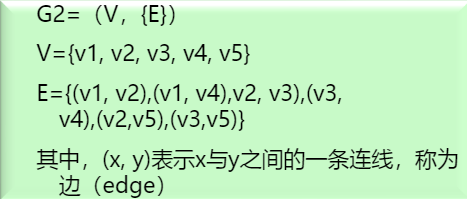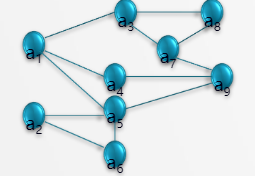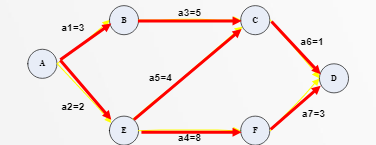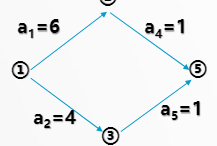图
前言
图允许数据元素可以有多个前驱,因此可以反映数据元素之间多对多的关系
一、图的基本概念
- 图可以分为有向图和无向图。
- 图G=(V,E)由顶点集V(G)和关系集E(G)组成,当E(G)为空集时图G只有顶点没有边。
- 完全图:边数达到最大的图,无向完全图的边数为n(n-1)/2;有向完全图的边数为n(n-1)
- 权:与图的边或弧相关的数
- 网:边或弧上带有权值的图
- 顶点的度TD(V)
无向图:依附于顶点V的边数
有向图:等于V的入度与顶点V的出度之和,记为OD(V)
TD(V)=ID(V)+OD(V)
- 路径
路径长度:边或弧的数目之和
回路和幻:首尾相连
简单路径:路径中不含有相同顶点
简单回路:除首尾顶点外路径不含相同顶点的回路。
- 连通
如果V-> V’有路径则为连通- 连通图
无向图:图中任意两个点都是连通的则称为无向连通图
有向图:图中任意两个点都存在双向连通路径则为强连通图
- 连通分量
无向图中极大连通子图为连通分量
有向图中极大强连通子图为强连通分量
单个结点可以自己构成一个强连通分量
- 生成树
设无向图G是含有N个顶点的连通图,则G的生成树含有N个结点且只有N-1条边的连通子图n个顶点
n-1条边
连通
- 子图
有向图

无向图

二、图的存储
1.顺序存储-邻接矩阵
数组表示法:设图G=(V,{E})有n个顶点,则G的邻接矩阵定义为n阶方阵A。

无向图中:顶点Vi的度等于邻接矩阵第i行非零元素的个数之和。
有向图中:顶点Vi的度等于邻接矩阵第i行和第i列非零元素的个数之和。

template <typename T>
class Mgraph
{
public:
char VerterType;
int EdgeType;
VerterType vexs[MaxVeterNum];
EdgeType edges[MaxVeterNum];
int n, e;
void creatMgraph(Mgraph *G)
};
template<typename T>
void Mgraph<T>::creatMgraph(Mgraph* G) {
int i, j, k, w;
scanf_s("%d%d", &G->n, &G->e);
for ( i = 0; i <G->n; i++)
{
G->vexs[i] = getchar();
}
for ( i = 0; i < G->n; i++)
{
for ( j = 0; j < G->n; j++)
{
G->edges[i][j] = 0;
}
}
for ( k = 0; k < G->e; k++)
{
scanf_s("%d%d", &i, &j);
G->edges[i][j] = 1;
G->edges[j][i] = 1;
}
}
2.链式存储-邻接表
邻接表需要由一个头节点的顺序表+他的所有相邻节点的链表所组成
转载自:https://blog.csdn.net/weixin_39469127/article/details/81082019
//文件名:"GraphAdjList.h"
#pragma once
#ifndef GRAPHADJLISL_H_
#define GRAPHADJLISL_H_
#include <string>
#include "ObjArrayList.h"
using namespace std;
/*
. 图(邻接表实现) Graph Adjacency List
. 相关术语:
. 顶点 Vertex ; 边 Arc ;权 Weight ;
. 有向图 Digraph ;无向图 Undigraph ;
. 有向网 Directed Network ;无向网 Undirected Network ;
. 存储结构:
. 1.顶点表只能采用顺序结构。(因为若采用链式结构,顶点结点定义与边表结点定义就相互引用,无法定义)
. 2.边表采用链表结构。
*/
class GraphAdjList
{
/*
. 边表(链表)结点
*/
struct ArcNode
{
int adjVex; //邻接顶点所在表中下标
int weight; //边权重
ArcNode * next; //下一条边
};
/*
. 顶点表(顺序表)结点
*/
struct VNode
{
string name; //顶点名
ArcNode * first; //指向的第一个依附该顶点的顶点边结点
};
public:
/*
. 图 种类
*/
enum GraphType
{
DG, //有向图,默认 0
UDG, //无向图,默认 1
DN, //有向网,默认 2
UDN //无向网,默认 3
};
/*
. 边(弧)数据,注:供外部初始化边数据使用
*/
struct ArcData
{
string Tail; //弧尾
string Head; //弧头
int Weight; //权重
};
private:
static const int _MAX_VERTEX_NUM = 10; //支持最大顶点数
VNode vexs[_MAX_VERTEX_NUM]; //顶点表
int vexs_visited[_MAX_VERTEX_NUM]; //顶点访问标记数组:0|未访问 1|已访问
int vexNum; //顶点数
int arcNum; //边数
int type; //图种类
void _CreateVexSet(ObjArrayList<string> * vexs); //创建顶点集合
void _CreateDG(ObjArrayList<ArcData> * arcsList); //创建有向图
void _CreateUDG(ObjArrayList<ArcData> * arcsList); //创建无向图
void _CreateDN(ObjArrayList<ArcData> * arcsList); //创建有向网
void _CreateUDN(ObjArrayList<ArcData> * arcsList); //创建无向网
int _Locate(string vertex); //定位顶点元素位置
void _InsertArc(int tail, int head, int weight); //插入边(元操作,不分有向/无向)
void _DeleteArc(int tail, int head); //删除边(元操作,不分有向/无向)
void _DFS_R(int index); //深度优先遍历 递归
void _DFS(int index); //深度优先遍历 非递归
public:
GraphAdjList(int type); //构造函数:初始化图种类
~GraphAdjList(); //析构函数
void Init(ObjArrayList<string> * vexs, ObjArrayList<ArcData> * arcsList); //初始化顶点、边数据为 图|网
void InsertArc(ArcData * arcData); //插入边(含有向/无向操作)
void DeleteArc(ArcData * arcData); //删除边(含有向/无向操作)
void Display(); //显示 图|网
void Display_DFS_R(string *vertex); //从指定顶点开始,深度优先 递归 遍历
void Display_DFS(string *vertex); //从指定顶点开始,深度优先 非递归 遍历
void Display_BFS(string *vertex); //从指定顶点开始,广度优先遍历
};
//文件名:"GraphAdjList.cpp"
#include "stdafx.h"
#include <string>
#include "ObjArrayList.h"
#include "LinkQueue.h"
#include "LinkStack.h"
#include "GraphAdjList.h"
using namespace std;
GraphAdjList::GraphAdjList(int type)
{
/*
. 构造函数:初始化图类型
*/
this->type = type;
this->vexNum = 0;
this->arcNum = 0;
}
GraphAdjList::~GraphAdjList()
{
/*
. 析构函数:销毁图
*/
}
void GraphAdjList::Init(ObjArrayList<string> * vexs, ObjArrayList<ArcData> * arcsList)
{
/*
. 初始化顶点、边数据,并构建 图|网
. 入参:
. vexs: 顶点 列表
. arcsList: 边数据 列表
*/
//1.创建顶点集
_CreateVexSet(vexs);
//2.根据图类型,创建指定的图
switch (this->type)
{
case DG:
_CreateDG(arcsList); break;
case UDG:
_CreateUDG(arcsList); break;
case DN:
_CreateDN(arcsList); break;
case UDN:
_CreateUDN(arcsList); break;
default:
break;
}
}
void GraphAdjList::_CreateVexSet(ObjArrayList<string> * vexs)
{
/*
. 创建顶点集合
*/
string vertex = "";
//顶点最大数校验
if (vexs->Length() > this->_MAX_VERTEX_NUM)
{
return;
}
//遍历顶点表,无重复插入顶点,并计数顶点数
for (int i = 0; i < vexs->Length(); i++)
{
vertex = *vexs->Get(i);
if (_Locate(vertex) == -1)
{
this->vexs[this->vexNum].name = vertex;
this->vexs[this->vexNum].first = NULL;
this->vexNum++;
}
}
}
void GraphAdjList::_CreateDG(ObjArrayList<ArcData> * arcsList)
{
/*
. 创建有向图
. 邻接矩阵为 非对称边
*/
//初始化临时 边对象
ArcData * arcData = NULL;
//初始化 Tail Head 顶点下标索引
int tail = 0, head = 0;
//遍历边数据列表
for (int i = 0; i < arcsList->Length(); i++)
{
//按序获取边(弧)
arcData = arcsList->Get(i);
//定位(或设置)边的两端顶点位置
tail = _Locate(arcData->Tail);
head = _Locate(arcData->Head);
//插入边
_InsertArc(tail, head, 0);
}
}
void GraphAdjList::_CreateUDG(ObjArrayList<ArcData> * arcsList)
{
/*
. 创建无向图
. 邻接矩阵为 对称边
*/
//初始化临时 边对象
ArcData * arcData = NULL;
//初始化 Tail Head 顶点下标索引
int tail = 0, head = 0;
//遍历边数据列表
for (int i = 0; i < arcsList->Length(); i++)
{
//按序获取边(弧)
arcData = arcsList->Get(i);
//定位(或设置)边的两端顶点位置
tail = _Locate(arcData->Tail);
head = _Locate(arcData->Head);
//插入对称边
_InsertArc(tail, head, 0);
_InsertArc(head, tail, 0);
}
}
void GraphAdjList::_CreateDN(ObjArrayList<ArcData> * arcsList)
{
/*
. 创建有向网
. 邻接矩阵为 非对称矩阵
*/
//初始化临时 边对象
ArcData * arcData = NULL;
//初始化 Tail Head 顶点下标索引
int tail = 0, head = 0;
//遍历边数据列表
for (int i = 0; i < arcsList->Length(); i++)
{
//按序获取边(弧)
arcData = arcsList->Get(i);
//定位(或设置)边的两端顶点位置
tail = _Locate(arcData->Tail);
head = _Locate(arcData->Head);
//插入边
_InsertArc(tail, head, arcData->Weight);
}
}
void GraphAdjList::_CreateUDN(ObjArrayList<ArcData> * arcsList)
{
/*
. 创建无向网
. 邻接矩阵为 对称矩阵
*/
//初始化临时 边对象
ArcData * arcData = NULL;
//初始化 Tail Head 顶点下标索引
int tail = 0, head = 0;
//遍历边数据列表
for (int i = 0; i < arcsList->Length(); i++)
{
//按序获取边(弧)
arcData = arcsList->Get(i);
//定位(或设置)边的两端顶点位置
tail = _Locate(arcData->Tail);
head = _Locate(arcData->Head);
//插入对称边
_InsertArc(tail, head, arcData->Weight);
_InsertArc(head, tail, arcData->Weight);
}
}
int GraphAdjList::_Locate(string vertex)
{
/*
. 定位顶点元素位置
. 后期可改成【字典树】,顶点数超过100个后定位顶点位置可更快
*/
//遍历定位顶点位置
for (int i = 0; i < this->_MAX_VERTEX_NUM; i++)
{
if (vertex == this->vexs[i].name)
{
return i;
}
}
//cout << endl << "顶点[" << vertex << "]不存在。" << endl;
return -1;
}
void GraphAdjList::_InsertArc(int tail, int head, int weight)
{
/*
. 插入边(元操作,不分有向/无向)
*/
//边结点指针:初始化为 弧尾 指向的第一个边
ArcNode * p = this->vexs[tail].first;
//初始化 前一边结点的指针
ArcNode * q = NULL;
//重复边布尔值
bool exist = false;
//1.边的重复性校验
while (p != NULL)
{
//若已存在该边,则标记为 存在 true
if (p->adjVex == head)
{
exist = true;
break;
}
//若不是该边,继续下一个边校验
q = p;
p = p->next;
}
//2.1.如果边存在,则跳过,不做插入
if (exist)
return;
//2.2.边不存在时,创建边
ArcNode * newArc = new ArcNode();
newArc->adjVex = head;
newArc->weight = weight;
newArc->next = NULL;
//3.1.插入第一条边
if (q == NULL)
{
this->vexs[tail].first = newArc;
}
//3.2.插入后序边
else
{
q->next = newArc;
}
//4.边 计数
this->arcNum++;
}
void GraphAdjList::InsertArc(ArcData * arcData)
{
/*
. 插入边(含有向/无向操作)
*/
//初始化 Tail Head 顶点下标索引
int tail = 0, head = 0;
tail = _Locate(arcData->Tail);
head = _Locate(arcData->Head);
//根据图类型,插入边
switch (this->type)
{
case DG:
_InsertArc(tail, head, 0);
break;
case UDG:
_InsertArc(tail, head, 0);
_InsertArc(head, tail, 0);
break;
case DN:
_InsertArc(tail, head, arcData->Weight);
break;
case UDN:
_InsertArc(tail, head, arcData->Weight);
_InsertArc(head, tail, arcData->Weight);
break;
default:
break;
}
}
void GraphAdjList::_DeleteArc(int tail, int head)
{
/*
. 删除边(元操作,不分有向/无向)
*/
//边结点指针:初始化为 弧尾 指向的第一个边
ArcNode * p = this->vexs[tail].first;
//初始化 前一边结点的指针
ArcNode * q = NULL;
//1.遍历查找边
while (p != NULL)
{
//若存在该边,则结束循环
if (p->adjVex == head)
{
break;
}
//若不是该边,继续下一个边
q = p;
p = p->next;
}
//2.1.边不存在
if (p == NULL)
{
cout << endl << "边[" << this->vexs[head].name << "->" << this->vexs[head].name << "]不存在。" << endl;
return;
}
//2.2.边存在,删除边
//2.2.1.若为第一条边
if (q == NULL)
{
this->vexs[tail].first = p->next;
}
//2.2.2.非第一条边
else
{
q->next = p->next;
}
//3.释放 p
delete p;
}
void GraphAdjList::DeleteArc(ArcData * arcData)
{
/*
. 删除边(含有向/无向操作)
*/
//初始化 Tail Head 顶点下标索引
int tail = 0, head = 0;
tail = _Locate(arcData->Tail);
head = _Locate(arcData->Head);
//根据图类型,删除边
switch (this->type)
{
case DG:
_DeleteArc(tail, head);
break;
case UDG:
_DeleteArc(tail, head);
_DeleteArc(head, tail);
break;
case DN:
_DeleteArc(tail, head);
break;
case UDN:
_DeleteArc(tail, head);
_DeleteArc(head, tail);
break;
default:
break;
}
}
void GraphAdjList::Display()
{
/*
. 显示 图|网
*/
//初始化边表结点指针
ArcNode * p = NULL;
cout << endl << "邻接表:" << endl;
//遍历顶点表
for (int i = 0; i < this->_MAX_VERTEX_NUM; i++)
{
//空顶点(在删除顶点的操作后会出现此类情况)
if (this->vexs[i].name == "")
{
continue;
}
//输出顶点
cout << "[" << i << "]" << this->vexs[i].name << " ";
//遍历输出边顶点
p = this->vexs[i].first;
while (p != NULL)
{
cout << "[" << p->adjVex << "," << p->weight << "] ";
p = p->next;
}
cout << endl;
}
}
void GraphAdjList::_DFS_R(int index)
{
/*
. 深度优先遍历 递归
*/
//1.访问顶点,并标记已访问
cout << this->vexs[index].name << " ";
this->vexs_visited[index] = 1;
//2.遍历访问其相邻顶点
ArcNode * p = this->vexs[index].first;
int adjVex = 0;
while (p != NULL)
{
adjVex = p->adjVex;
//当顶点未被访问过时,可访问
if (this->vexs_visited[adjVex] != 1)
{
_DFS_R(adjVex);
}
p = p->next;
}
}
void GraphAdjList::Display_DFS_R(string *vertex)
{
/*
. 从指定顶点开始,深度优先 递归 遍历
*/
//1.判断顶点是否存在
int index = _Locate(*vertex);
if (index == -1)
return;
//2.初始化顶点访问数组
for (int i = 0; i < this->_MAX_VERTEX_NUM; i++)
{
this->vexs_visited[i] = 0;
}
//3.深度优先遍历 递归
cout << "深度优先遍历(递归):(从顶点" << *vertex << "开始)" << endl;
_DFS_R(index);
}
void GraphAdjList::_DFS(int index)
{
/*
. 深度优先遍历 非递归
*/
//1.访问第一个结点,并标记为 已访问
cout << this->vexs[index].name << " ";
vexs_visited[index] = 1;
//初始化 边结点 栈
LinkStack<ArcNode> * s = new LinkStack<ArcNode>();
//初始化边结点 指针
ArcNode * p = this->vexs[index].first;
//2.寻找下一个(未访问的)邻接结点
while (!s->Empty() || p != NULL)
{
//2.1.未访问过,则访问 (纵向遍历)
if (vexs_visited[p->adjVex] != 1)
{
//访问结点,标记为访问,并将其入栈
cout << this->vexs[p->adjVex].name << " ";
vexs_visited[p->adjVex] = 1;
s->Push(p);
//指针 p 移向 此结点的第一个邻接结点
p = this->vexs[p->adjVex].first;
}
//2.2.已访问过,移向下一个边结点 (横向遍历)
else
p = p->next;
//3.若无邻接点,则返回上一结点层,并出栈边结点
if (p == NULL)
{
p = s->Pop();
}
}
//释放 栈
delete s;
}
void GraphAdjList::Display_DFS(string *vertex)
{
/*
. 从指定顶点开始,深度优先 非递归 遍历
*/
//1.判断顶点是否存在
int index = _Locate(*vertex);
if (index == -1)
return;
//2.初始化顶点访问数组
for (int i = 0; i < this->_MAX_VERTEX_NUM; i++)
{
this->vexs_visited[i] = 0;
}
//3.深度优先遍历 递归
cout << "深度优先遍历(非递归):(从顶点" << *vertex << "开始)" << endl;
_DFS(index);
}
void GraphAdjList::Display_BFS(string *vertex)
{
/*
. 从指定顶点开始,广度优先遍历
*/
//1.判断顶点是否存在
int index = _Locate(*vertex);
if (index == -1)
return;
//2.初始化顶点访问数组
for (int i = 0; i < this->_MAX_VERTEX_NUM; i++)
{
this->vexs_visited[i] = 0;
}
//3.广度优先遍历
cout << "广度优先遍历:(从顶点" << *vertex << "开始)" << endl;
//3.1.初始化队列
LinkQueue<int> * vexQ = new LinkQueue<int>();
//3.2.访问开始顶点,并标记访问、入队
cout << this->vexs[index].name << " ";
this->vexs_visited[index] = 1;
vexQ->EnQueue(new int(index));
//3.3.出队,并遍历邻接顶点(下一层次),访问后入队
ArcNode * p = NULL;
int adjVex = 0;
while (vexQ->GetHead() != NULL)
{
index = *vexQ->DeQueue();
p = this->vexs[index].first;
//遍历邻接顶点
while (p != NULL)
{
adjVex = p->adjVex;
//未访问过的邻接顶点
if (this->vexs_visited[adjVex] != 1)
{
//访问顶点,并标记访问、入队
cout << this->vexs[adjVex].name << " ";
this->vexs_visited[adjVex] = 1;
vexQ->EnQueue(new int(adjVex));
}
p = p->next;
}
}
//4.释放队列
int * e;
while (vexQ->GetHead() != NULL)
{
e = vexQ->DeQueue();
delete e;
}
delete vexQ;
}
//文件名:"GraphAdjList_Test.cpp"
#include "stdafx.h"
#include <iostream>
#include "GraphAdjList.h"
#include "ObjArrayList.h"
using namespace std;
int main()
{
//初始化顶点数据
string * v1 = new string("v1");
string * v2 = new string("v2");
string * v3 = new string("v3");
string * v4 = new string("v4");
string * v5 = new string("v5");
string * v6 = new string("v6");
string * v7 = new string("v7");
ObjArrayList<string> * vexs = new ObjArrayList<string>();
vexs->Add(v1);
vexs->Add(v2);
vexs->Add(v3);
vexs->Add(v4);
vexs->Add(v5);
vexs->Add(v6);
vexs->Add(v7);
//初始化边(弧)数据
GraphAdjList::ArcData * arc1 = new GraphAdjList::ArcData{ "v1", "v2", 2 };
GraphAdjList::ArcData * arc2 = new GraphAdjList::ArcData{ "v1", "v3", 3 };
GraphAdjList::ArcData * arc3 = new GraphAdjList::ArcData{ "v1", "v4", 4 };
GraphAdjList::ArcData * arc4 = new GraphAdjList::ArcData{ "v3", "v1", 5 };
GraphAdjList::ArcData * arc5 = new GraphAdjList::ArcData{ "v3", "v2", 6 };
GraphAdjList::ArcData * arc6 = new GraphAdjList::ArcData{ "v3", "v5", 7 };
GraphAdjList::ArcData * arc7 = new GraphAdjList::ArcData{ "v2", "v5", 8 };
GraphAdjList::ArcData * arc8 = new GraphAdjList::ArcData{ "v4", "v6", 9 };
GraphAdjList::ArcData * arc9 = new GraphAdjList::ArcData{ "v4", "v7", 9 };
GraphAdjList::ArcData * arc10 = new GraphAdjList::ArcData{ "v6", "v7", 9 };
ObjArrayList<GraphAdjList::ArcData> * arcsList = new ObjArrayList<GraphAdjList::ArcData>();
arcsList->Add(arc1);
arcsList->Add(arc2);
arcsList->Add(arc3);
arcsList->Add(arc4);
arcsList->Add(arc5);
arcsList->Add(arc6);
arcsList->Add(arc7);
arcsList->Add(arc8);
arcsList->Add(arc9);
arcsList->Add(arc10);
//测试1:无向图
cout << endl << "无向图初始化:" << endl;
GraphAdjList * udg = new GraphAdjList(GraphAdjList::UDG);
udg->Init(vexs, arcsList);
udg->Display();
//1.1.深度优先遍历
cout << endl << "无向图深度优先遍历序列:(递归)" << endl;
udg->Display_DFS_R(v1);
cout << endl << "无向图深度优先遍历序列:(非递归)" << endl;
udg->Display_DFS(v1);
//1.2.广度优先遍历
cout << endl << "无向图广度优先遍历序列:" << endl;
udg->Display_BFS(v2);
//1.3.插入新边
cout << endl << "无向图新边:" << endl;
udg->InsertArc(new GraphAdjList::ArcData{ "v7", "v1", 8 });
udg->Display();
//1.4.删除边
cout << endl << "无向图删除边arc9:" << endl;
udg->DeleteArc(arc9);
udg->Display();
//测试2:有向图
cout << endl << "有向图:" << endl;
GraphAdjList * dg = new GraphAdjList(GraphAdjList::DG);
dg->Init(vexs, arcsList);
dg->Display();
//2.1.深度优先遍历
cout << endl << "有向图深度优先遍历序列:(递归)" << endl;
dg->Display_DFS_R(v1);
cout << endl << "有向图深度优先遍历序列:(非递归)" << endl;
dg->Display_DFS(v1);
//2.2.广度优先遍历
cout << endl << "有向图广度优先遍历序列:" << endl;
dg->Display_BFS(v2);
//测试:无向网
cout << endl << "无向网:" << endl;
GraphAdjList * udn = new GraphAdjList(GraphAdjList::UDN);
udn->Init(vexs, arcsList);
udn->Display();
//测试:有向网
cout << endl << "有向网:" << endl;
GraphAdjList * dn = new GraphAdjList(GraphAdjList::DN);
dn->Init(vexs, arcsList);
dn->Display();
return 0;
}
代码如下(示例):
import numpy as np
import pandas as pd
import matplotlib.pyplot as plt
import seaborn as sns
import warnings
warnings.filterwarnings('ignore')
import ssl
ssl._create_default_https_context = ssl._create_unverified_context
三.图的遍历
3.1深度优先搜索DFS
- 访问指定的结点v,将v作为结点
- 访问下一个未被访问的邻接点,将其作为当前顶点
- 重复上一过程直到所有的邻接点都被访问过(此时可能并不是所有的结点都被访问过)
- 沿搜索路径回退,退回到有邻接点尚未被访问的结点,重复2
可以用递归或者stack实现
代码在上面
3.2广度优先搜索BFS
- 首先访问顶点V,将V作为当前顶点
- 访问当前顶点的所有未访问过的邻接点,并将依次访问的这些邻接点作为当前顶点
- 重复2直到所有顶点被访问
- 可以用queue实现
四.贪心算法
贪心算法并不从整体最优考虑,每一次的贪心算法都是对当前形势上的局部最优解,我们希望这些局部最优解能够得到整体最优解。贪心算法多应用于最短路径/最小生成树,最优仓库存储管理,航空管制系统,邮递员等问题。
- 基本步骤
- 建立数学模型
- 将求解的问题分为若干个子问题(有点像递归)
- 得到子问题局部最优解
- 得到全局解
4.1贪心算法基本要素
- 贪心选择性质:整体最优解可以由局部最优解得到
- 最优子结构性质:整体最优解包含子问题的最优解
待补充
五.最小生成树
- prim’s算法
- kruskal’s算法
- 重复删除算法
5.1两个性质特点
回路与切分


5.2 Prim算法
dv表示路径的权重,pv表示最后一个影响边权重的结点。利用贪心算法的思想在每次一连接节点时都选择最短的权重去链接
5.3kruskal算法
注意:在Kruskal算法中,顶点连接之前需要先对边的权重进行排序时间为O(nlogn)
5.4 Prim与Kurskal性能对比
Prim算法
以连通为主,(n-1)次连接
时间复杂度与边无关为O(n2)
适合于求边稠密网的最小生成树(顶点数较少,边数较多)
Kurskal算法
以最小代价为主,添加不形成回路的最小代价边
时间复杂度与边有关为O(nlog2n)
适合于求边稀疏网的最小生成树(顶点数较多,边数较少)
六.最短路径(Dijistra)
图论学习之Dijkstra算法的总结
转载自:yanping liang
七.拓扑排序
将非线性的有向图转化为线性排序
AOV图:
顶点表示活动,弧表示活动的先后次序。
如果有回路工程就无法结束。

算法步骤:
- 在图中选取一个没有前驱的结点作为顶点
- 删除该顶点和以它为弧尾的弧
- 重复以上两部直到图中的所有顶点都输出(得到拓扑排序的有序序列)或图中没有前驱的顶点即没有环状结构。
八.关键路径
AOE图:顶点表示事件(时间很短),弧表示活动(权表时间)。AOE只有一个入度为0的源点表示工程的开始和一个出度为0的汇点表示工程的结束。

e.g.下图中只有在a4和a5都完成后才能到达5.

算法分析:
- 工程图必须是有向无环图
- 工期是从源点到汇点的最短完成时间,即某一条到汇点的路径最长时间是汇点开始的最早时间。
-
利用拓扑排序来求各个事件的最早开始时间。
- 在工期不变的情况下,求各个事件的最晚开始时间。若某些事件的最早开始时间和最晚开始时间相同,则这些事件就是关键活动上的事件,可以求出关键活动和关键路径。
-
从汇点开始倒推每个结点的最晚开始时间。利用拓扑排序从汇点开始求每个活动开始事件的最晚时间。


























 1046
1046











 被折叠的 条评论
为什么被折叠?
被折叠的 条评论
为什么被折叠?








